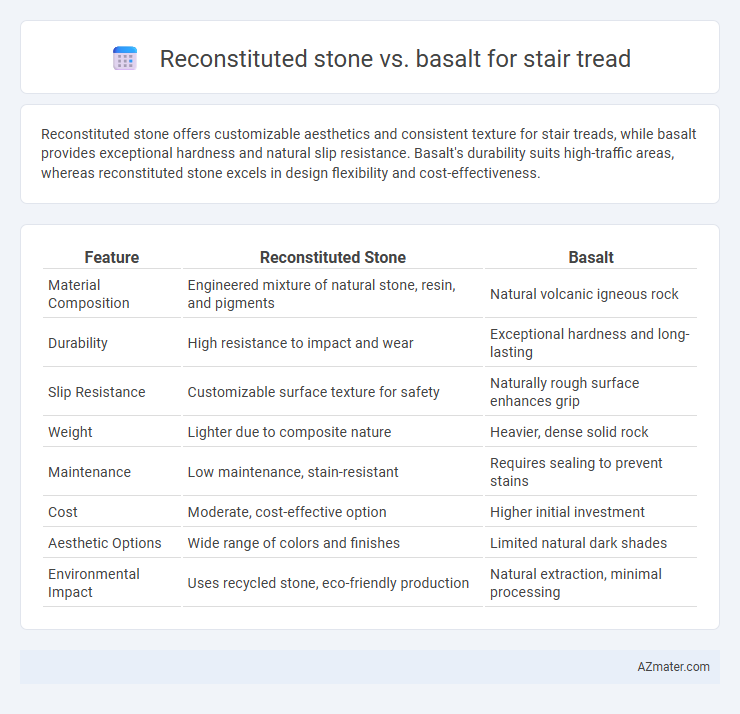Reconstituted stone offers customizable aesthetics and consistent texture for stair treads, while basalt provides exceptional hardness and natural slip resistance. Basalt's durability suits high-traffic areas, whereas reconstituted stone excels in design flexibility and cost-effectiveness.
Table of Comparison
| Feature | Reconstituted Stone | Basalt |
|---|---|---|
| Material Composition | Engineered mixture of natural stone, resin, and pigments | Natural volcanic igneous rock |
| Durability | High resistance to impact and wear | Exceptional hardness and long-lasting |
| Slip Resistance | Customizable surface texture for safety | Naturally rough surface enhances grip |
| Weight | Lighter due to composite nature | Heavier, dense solid rock |
| Maintenance | Low maintenance, stain-resistant | Requires sealing to prevent stains |
| Cost | Moderate, cost-effective option | Higher initial investment |
| Aesthetic Options | Wide range of colors and finishes | Limited natural dark shades |
| Environmental Impact | Uses recycled stone, eco-friendly production | Natural extraction, minimal processing |
Introduction: Reconstituted Stone vs Basalt for Stair Treads
Reconstituted stone offers a versatile and cost-effective alternative to natural basalt for stair treads, featuring enhanced uniformity and customizable aesthetics. Basalt, a dense volcanic rock, provides exceptional durability and slip resistance, ideal for high-traffic areas requiring robust performance. Comparing their mechanical strength, weather resistance, and maintenance requirements highlights key factors influencing material selection for stair tread applications.
Material Composition and Formation
Reconstituted stone for stair treads is composed of crushed natural stone aggregates combined with resins or cement binders, allowing precise control over texture and coloration. Basalt, a volcanic igneous rock, forms naturally through the rapid cooling of lava, resulting in a dense, fine-grained material renowned for its durability and heat resistance. The engineered composition of reconstituted stone offers customization and uniformity, while basalt provides inherent strength and natural variation due to its geological formation.
Aesthetic Appeal and Design Flexibility
Reconstituted stone offers superior design flexibility for stair treads due to its customizable colors, textures, and finishes that can mimic natural stones like marble or granite, allowing architects to achieve specific aesthetic visions. Basalt provides a distinctive, natural dark gray tone with a fine-grained texture, lending a sleek, modern appearance ideal for minimalist or industrial designs but with limited color variation. The choice between reconstituted stone and basalt depends on whether the priority is personalized aesthetic appeal or the raw, natural beauty inherent to volcanic rock.
Durability and Longevity
Reconstituted stone offers consistent durability with resistance to chipping and cracking, making it suitable for stair treads exposed to regular foot traffic. Basalt, a natural volcanic rock, provides exceptional hardness and long-lasting wear resistance, ensuring superior longevity in high-use environments. Both materials excel in durability, but basalt generally outperforms reconstituted stone in maintaining structural integrity over extended periods.
Slip Resistance and Safety
Reconstituted stone stair treads offer consistent slip resistance due to their engineered surface texture, which can be customized to meet specific safety standards, reducing the risk of slipping accidents. Basalt stair treads, naturally dense and rough, provide excellent inherent slip resistance due to their granular texture and natural cleft surface, making them highly durable and safe in wet or high-traffic areas. Both materials are effective for stair safety, but basalt's natural texture often requires less maintenance to sustain slip resistance over time.
Maintenance and Cleaning Requirements
Reconstituted stone stair treads require regular cleaning with non-abrasive, pH-neutral detergents to prevent surface damage and staining, making maintenance relatively straightforward but consistent. Basalt stair treads are naturally dense and resistant to wear, requiring minimal cleaning with mild soap and water; their porous nature demands periodic sealing to maintain durability and appearance. Choosing between these materials hinges on balancing the ease of reconstituted stone's routine care against basalt's need for occasional sealing and its superior long-term resilience.
Cost Comparison and Value
Reconstituted stone stair treads generally offer a lower initial cost compared to basalt, making them an economical choice for budget-conscious projects without sacrificing aesthetics. Basalt, while more expensive upfront due to its natural durability and resistance to wear, provides superior long-term value as it requires less maintenance and has a longer lifespan in high-traffic areas. Choosing between the two depends on balancing immediate budget constraints with the desired longevity and resilience of the stair treads.
Environmental Impact and Sustainability
Reconstituted stone stair treads offer enhanced sustainability through the use of recycled materials and lower embodied energy compared to basalt, which requires extensive quarrying and energy-intensive processing. Basalt, while naturally durable and long-lasting, contributes to habitat disruption and higher carbon emissions during extraction and transportation. Opting for reconstituted stone stair treads reduces environmental footprint by minimizing resource depletion and enabling circular economy practices in construction.
Installation Process and Ease
Reconstituted stone offers a more uniform and lightweight option for stair tread installation, enabling quicker cuts and easier handling compared to dense basalt. Basalt requires specialized tools and more labor-intensive installation due to its hardness and weight, which can extend project timelines. The ease of working with reconstituted stone reduces installation costs, while basalt's durability may justify the more complex process in high-traffic or exterior applications.
Best Applications and Recommendations
Reconstituted stone offers excellent versatility and cost-effectiveness for interior stair treads, excelling in controlled environments due to its uniformity and design flexibility. Basalt is highly recommended for exterior or high-traffic stair treads because of its exceptional durability, natural slip resistance, and superior resistance to weathering. For optimal performance, choose reconstituted stone in residential settings with moderate wear and basalt for commercial or outdoor installations demanding enhanced strength and longevity.

Infographic: Reconstituted stone vs Basalt for Stair tread
 azmater.com
azmater.com